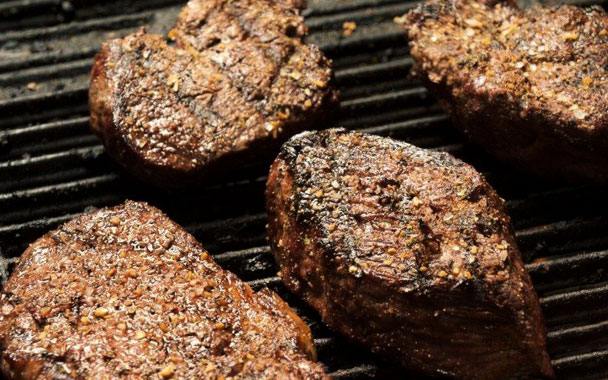It’s hard to imagine a meat better suited to the backyard fire than bison. This red, robust meat—laced with wild but un-gamey open-range flavors of dust, sage, and blood—looks a lot like beef. But it’s not beef.
For one thing, it’s raised very differently than most of the beef we eat. For another, its makeup is different: Bison contains around three-quarters less fat than comparable cuts of beef. This makes it more healthful (the good news), but also trickier to cook (the not-so-good news, until you learn).
Fat is a good fire buffer for meat when you’re when grilling; it helps beef maintain its suppleness even if it is cooked too long. Not so with bison, which is slighty more exacting because its leanness makes the high heat of a grill less forgiving.
Novice bison-grillers (guilty!) will find this out the hard way. They’ll bring their bison New York Strips to room temperature, season liberally, and sear over the hottest part of the grill until the meat is charred, then they’ll cook it even longer. They’ll use the knife test (making a tiny incision in the center of the meat to eyeball its color) to check for medium-rare pinkness, see that the flesh is still ruby red, and let the steak sear for a few more minutes.
Problem is, the good old knife test doesn’t really work with bison. The bright red flesh doesn’t turn gray-brown as quickly as beef, so it retains the color we think of as “very rare” even when it’s cooked to medium-rare. Which is as far as you should cook it. Medium or well-done buffalo is tough, chewy, jerky-like. Less is more, with bison.
So you have to have, in the words of the late-great OSS agent Julia Child, “the courage of your convictions.” You also have to have a little bit less heat (let the coals cool an extra 15 minutes, or back the gas grill down to medium-high) and a clean, oiled grill about six inches from the flame. And, of course, a quick-read meat thermometer won’t hurt. (Your medium-rare bullseye is 130 degrees in the center.)
Bison cuts will sound familiar: Ribeye, strip, filet, rib roast, and so forth. The best on the grill is a strip steak, meaty and rich. Basic grilling rules apply: Season liberally, leave it alone while it’s cooking, and allow the meat to rest a few minutes after it’s done before slicing into it.
Bison meat lends itself beautifully to Mediterranean flavors, and is perfect with a savory salsa verde. (If bison is not locally available, you can mail order it from thefort.com, bisonfarm.com, or bisoncentral.com.)
Bison New York Strip
Makes 1 steak, enough for two people, with some leftovers for sandwiches
Ingredients
1 bison New York Strip, about 16 ounces, at room temperature. Steak should be about 1 1/2 inches thick.
About 1 tablespoon sea or kosher salt
Olive oil
Directions
Preheat grill to medium-high. If using charcoal, allow fire to cool about 15 minutes from hottest point. Create a “cool zone” at one end of the grill, with no direct heat beneath it. Clean and oil grill.
Rub steak with salt. Allow to sit for 15 minutes, then rub with olive oil.
Place steak on grill for 3 minutes, or until meat can be lifted easily with tongs. Flip and grill another 3 minutes. Remove steak to cool side of grill and allow to finish cooking, about 6-8 minutes for medium rare. A quick-read meat thermometer inserted into the center of the steak should read 130 degrees Fahrenheit.
Remove steak to cutting board, cover loosely with foil, and allow steak to rest for ten minutes. Slice steak into thin strips against the grain, and serve with salsa verde.

